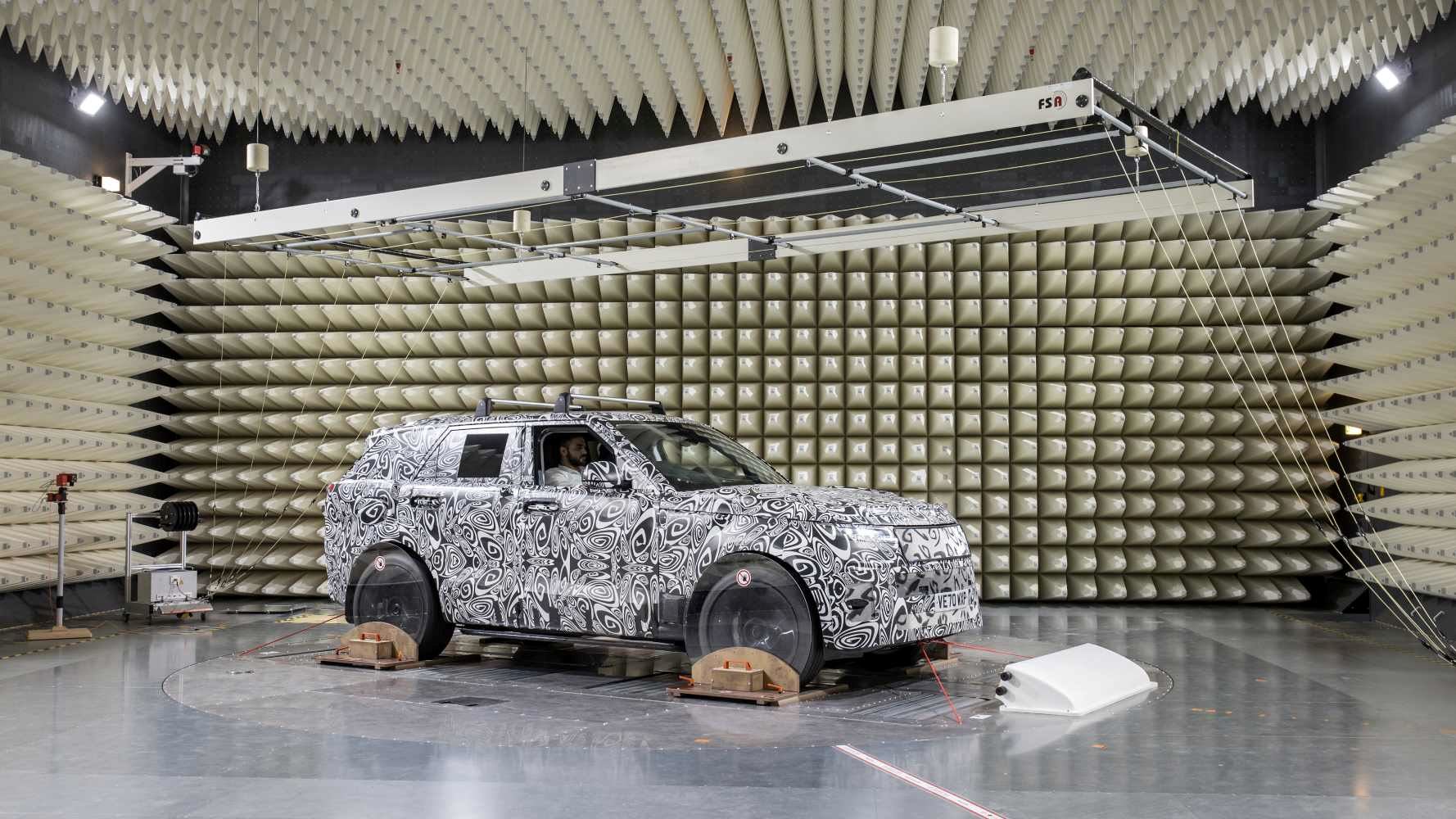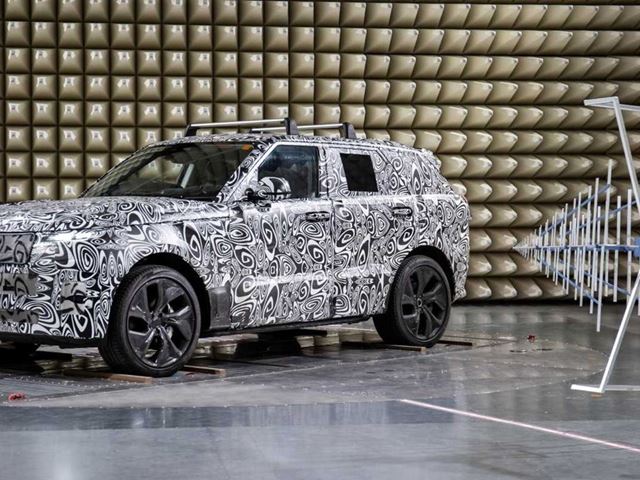
- Latest: Welcome to Auto Futures - Mobility News, Features, Exclusives and More...
- Latest: Subaru Europe Unveils the Brand's First All-Electric Compact SUV
- Latest: Lucid, Nuro & Uber Partner on Next-Generation Autonomous Robotaxi Service
- Latest: GM & Redwood Materials to Repurpose EV Batteries for Energy Storage
- Latest: Stellantis Discontinues Hydrogen Fuel Cell Technology Development Program
- Latest: Paving the way for an Electrified Future - L-Charge CEO
Ensuring Connected and Autonomous Cars Remain Safe with JLR's Peter Phillips

The automotive world is becoming increasingly connected and reliant on electronic tech.
However, despite the new range of features, this connectivity will bring, it is not without downsides. Earlier this month, Jaguar Land Rover (JLR) revealed a new facility to put its upcoming cars through their paces and ensure that they will be safe to use on the roads of tomorrow.
Called the Electromagnetic Compatibility (EMC) laboratory, the new site near the company's Gaydon headquarters has already started testing cars for electrical and radio interference, including the new Range Rover Sport.
To find out more about the facility and how it will change JLR's future cars, Auto Futures spoke to Peter Phillips, the company's Senior Manager, Electromagnetics and Compliance.
Understanding the Threats

"Cars are exposed to many sources of electromagnetic energy, such as TV and radio broadcasts, mobile phone masts, customer smartphones, and airport radar systems. All of these can cause electromagnetic interference (EMI) which can impact radio reception and cellular network coverage in vehicles," explains Phillips.
It might seem strange to consider that the signals our society rely on could be having an adverse impact on the cars we drive.
However, while today you might miss out on listening to the radio, the consequences of the interference might be far more serious in the future.
"The increasing number of electrical features on our vehicles, from driver assistance to connectivity services, plus the radio frequency (RF) energy generated by electric motors in Plug-in Electric Hybrid Vehicles (PHEVs) and fully electric vehicles, means EMC control is critical," says Phillips.
What's more, JLR's move away from the internal combustion engine and towards hybrid and electric vehicles such as the new Range Rover models and Jaguar i-Pace will have an impact on electromagnetic interference, as well.
"As we continuously add connected services and electronic systems and features to our vehicles, testing for EMI is more important than ever. Our move to electrification also has implications in this domain because electric motors generate electromagnetic energy," says Phillips.
Meeting the Problems
While Phillips says that JLR's cars are already designed to minimise the effects of electromagnetic interference, the growing number of threats has necessitated creating the new EMC lab.
"The EMC lab allows us to conduct vehicle tests to validate all the systems functioning together as intended when we subject them to simulated external sources like TV and radio transmitters," he explains.
The site includes a vast range of features that will allow JLR to test a range of threats and vulnerabilities and ensure that the cars it releases are safe to drive – regardless of where they are or what is around them.
"The Electromagnetic Compatibility (EMC) facility features two anechoic chambers," says Phillips.

"One contains an electrically ‘quiet’ rolling road that enables engineers to test vehicles in motion, at varying speeds, as well as equipment to assess the performance of individual components, such as batteries and electric motors. Bluetooth, GPS, WiFi, 4G, 5G, adaptive cruise control, wireless charging and blind spot monitoring are all examples of vehicle services and features that the facility will test for EMC."
The other chamber, meanwhile, is a component lab designed to test the high-voltage batteries and electric drive units. This chamber, Phillips says, is a first for JLR as it previously relied on its suppliers to test components before they received them.
Phillips says that JLR's plan to electrify its portfolio will increase the length of testing. However, the new lab will help the company manage its testing capacity and reduce its reliance on external facilities, helping to increase vehicle deliveries. But that's not all.
"The vehicle laboratory has been designed with a new four-wheel-drive system so that we can evaluate our new EV drive systems and prove that the system (tested at component level first) does not disrupt the radio in the vehicle. Also new to this laboratory is a high-power charge system so that we can recreate the charging process for electrified vehicles," says Phillips.
"We are also installing communication system tools to enable us to verify our phone, vehicle-to-vehicle/infrastructure (V2V/V2I), Bluetooth and Wi-Fi performance, including 5G communications, to support the future software-over-the-air features that Jaguar Land Rover is developing."
Future Challenges
The increasing number of autonomous vehicles and autonomous systems on the roads will present a variety of different challenges. Not only will drivers come to expect enhanced entertainment features to make the most of their newfound free time while travelling but a range of potential technical pitfalls might emerge.
"The external electromagnetic environment will not change significantly as transmitters are carefully controlled by legislation around the world," says Phillips.
"It is possible that interference could reduce the data throughput of some of the connectivity services, which is why we have invested in the communications simulation equipment now to ensure this does not happen as a result of vehicle level interference."
An increased number of automated features might also have an impact on the sensors used in cars.
"It's critical to ensure that the fused sensors are not affected by EMI. This process will also test that the inbuilt safety systems in software work correctly should a sensor be affected by an external electromagnetic source."
JLR, however, is confident in its ability to electrify and automate its model lineup.
"We are working on different levels of autonomous systems today and researching systems for the future; this includes our electromagnetic simulation team who are working on virtual test drives now to help develop the systems of the future," Phillips says.
"Our multi-year strategic partnership with NVIDIA is a demonstration of our commitment to autonomy and will allow us to jointly develop and deliver next-generation automated driving systems, plus AI-enabled services and experiences for customers. All new Jaguar Land Rover vehicles will be built on the NVIDIA DRIVE™ software-defined platform, which will deliver a major acceleration in the automated driving services available on our cars."
Despite uncertainty around the performance of connected and autonomous cars, JLR's new EMC will unequivocally help to keep drivers safe and push the company into a new era of driving.
